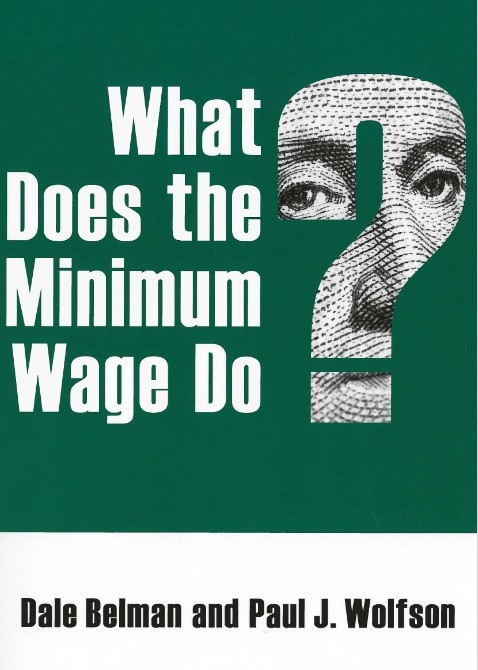What does the Minimum Wage Do?
Book from Upjohn Press
By Dale Belman, Michigan State University and Paul J. Wolfson, Dartmouth College
Available for free download
“. . . what has to be the most exhaustive existing analysis of the question of the impact of minimum wage increases on employment.” —Jared Bernstein
The minimum wage debate is, among other things, contentious, polarizing, and at the forefront of ongoing political debate. Some argue that raising the minimum wage will pull working individuals and families out of poverty while reducing income inequality at an acceptable cost to society. Others contend that raising the minimum wage is a job killer: that when the cost of labor increases, demand for that labor decreases. Supporters of this argument cite a February 2014 CBO report that points to potential job losses numbering 500,000 as a result of President Obama’s proposed national minimum wage increase to $10.10 an hour. Others, including noted economists, criticize the report for being based on “off-the-shelf estimates” and say that it fails to put an emphasis on the more rigorous studies examined in the report. And while policymakers have voted recently to increase the minimum wage in several states and municipalities, it will be years before the impacts of these increases, if any, will be detectable. The bottom line is that all the debate and recent action by policymakers does little to add clarity to the effects of raising the minimum wage.
A book from the Upjohn Press helps settle the issue. Based on a rigorous meta-analysis of more than 200 scholarly publications published since 1991 (most after 2000) that address the various impacts of raising the minimum wage, What Does the Minimum Wage Do? presents what has to be the most comprehensive, analytical, and unbiased assessment of the effects of minimum wage increases that has ever been produced. Authors Dale Belman and Paul J. Wolfson look at several outcomes influenced by increases in the minimum wage, how long it takes those outcomes to respond, the magnitude of effects, why increases in the minimum wage have the results they do, and the workers most likely to be impacted.
Their painstaking analysis focuses mainly on studies using data from the United States, but also includes studies that focus on Canada, Australia, New Zealand, the UK, and other western European nations. This breadth and depth of investigation on the impacts of hikes in the minimum wage clarifies the issues surrounding, among other things, employment, wages, poverty and inequality, and effect by gender, and allows them to conclude the following:
- Moderate increases in the minimum wage, characteristic of the United States over the last half of the twentieth century, have the effect that was intended by the original supporters of such action: raising the minimum wage substantially increases the earnings of those at the bottom of the income distribution and reduces wage inequality.
- Negative effects on employment resulting from increases in the minimum wage were too small to be statistically detectable in the meta-analysis. Therefore, Belman and Wolfson conclude, employment effects are too modest to have meaningful consequences for public policy in the dynamically changing U.S. labor market.
- Evidence of positive spillover effects on the wages of those earning slightly more than the new minimum wage is mixed, but it generally supports their existence, particularly for women.
- The minimum wage should be seen as one of a set of policy tools aimed at improving the standard of living of the less well-off, and moderate increases in the minimum wage would likely aid low-income individuals and families, with acceptable costs to the nation.

